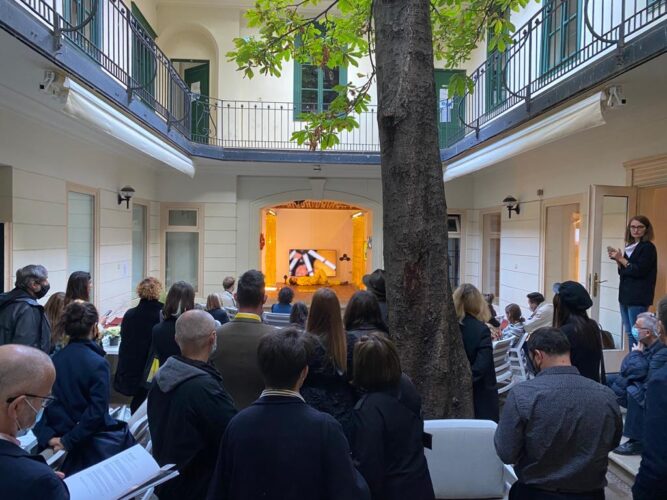
Opening night of Video+Radio+Live, live performance by Catinca Malaimare
On September 30 I went to the collective opening of VIDEO+RADIO+LIVE, organized by a number of Romanian contemporary art galleries – Catinca Tabacaru, Ivan, Plan B, Sandwich, Sector 1, and Suprainfinit – at Casa Artelor in Timișoara, as an associated event of the Art Encounters Biennial 2021. The event brings together video works, as well as live and recorded performance pieces, adapted to the current pandemic context, questioning and discovering new ways of intervening in a space in the absence of physical interaction or presence. Video and radio act as bridges between presented and represented forms, towards a form of redefining presence, connecting movement and sense, the visual and the somatic.
Bogdan Ghiu was the event’s special guest. His role was to give an account of the events, on the radio, in podcasts, and in a special recording of his narrativizations, which will later be distributed as a USB stick / disk. One notes a shift in perception when it comes to representation and interaction, reconsidering the occurrence of physical presence in exhibition spaces, which needs to be rethought and replaced with a series of new dispositions of motion, affect, sense, but also with a vocabulary created in situations where the participatory dimension becomes impossible within the unitary meaning of global events. Through his call to narrative discourse, Bogdan Ghiu’s proposal reconsiders this paradigm of participation in which the materiality, exhibition, and dominance of the visual is negotiated. What are we able to see in the absence of images? How can we become more present?
At the event, I decided to also take part in this new experimental and necessary way of seeing and participating. At that point I thought it would be interesting, upon contact with the space, to propose a new form of representing the exhibition, namely in the form of diary entries, containing personal reflections and notes, for which I will use the residues of my initial hermeneutics, the thoughts and notes I took throughout the nights.
The two main exhibition spaces, together with the garden in the inner courtyard, offer different means and dynamics of coming into contact with the works, which cross the barrier formed by the space’s architecture in a kind of circuit of frames, of screens that beckon you towards them, that you want to approach, rigorously, carefully, in turn. This disposition to see through the mediation of screens offers the possibility of certain resumptions, of contaminations of the present event with the archived one, of the sense of security that what you lost can always be resumed. The video works offer a multiplicity of contexts and visions that lend each other space, being united at the same time by a core idea, that of being visible in a context where participation and interaction are constrained and diminished by external events, often transformed from live events into recordings.
The productions displayed in the exhibition spaces, in the galleries, bring together, following Hito Steyerl, spectators-seekers-researchers, who are distributed throughout the gallery space in an incoherent fashion, forming a silent, absorbed, atomized crowd. I feel the presence of the visitors’ search, and in the middle of the commotion I discover a feeling of calmness before a screen, where I stop. I see two parallel frames dominated by the complementary colors red and blue, and a female character that appears, first in turn, then simultaneously, in the two frames, dressed in blue and red respectively, carrying a wooden pole on her shoulder. In the background I see a sculpture in the shape of a door. I learn that artist Arantxa Etchevveria’s Red Door and Blue Door starts from a different work – Apocalipsă/Beatus – a series of photomontages inspired by the representations of Spanish Beatuses in the 12th century. The video shows the performative display of a guard before a door, in a linear pose which requires concentration, awareness, meditation, and daydreaming.
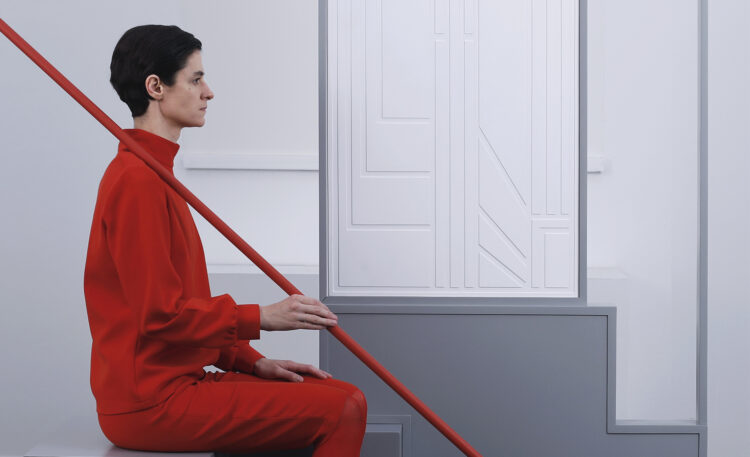
Arantxa Etcheverria, Red Door, 2021, video performance at VIDEO+RADIO+LIVE 2021, courtesy of Sector1 Gallery
Performer Ada Mușat’s very clear position erodes my attention, which turns into something closer to rest, a state that translates in terms of reflection, physical stillness, quietness, and wakefulness. The hubbub around me is replaced by stillness, and with the help of the formal techniques with which the spectator must divide their gaze, their attention from one frame to the next, with an unlikely difference, I notice an inherent, unclear dynamics between the two frames, which seem to rock you. On a phenomenological level, the slowed-down, static frames offer one the necessary time to receive an impression of the character and object, of the elements one directs their attention towards, analyzing them and transforming this technique of temporal duration into a technique of meditative observation. Starting from Deleuze’s division between movement-image and movement-time, I am able to understand duration and stillness within the episteme of a potential materiality which is given by a durational imperative and a time consumable in various structures and forms through which we come to interpret, mediate, and, perhaps, understand. I associate Arantxa Etchevveria’s work with terms like landscape, meditation, stasis, safety, position, cessation, stop, composition, silence.
In this moment two things draw my attention, and I feel I have to move: a screen nearby in which I notice another pole carried by artist Sanja Latinović on both shoulders, which makes me turn my gaze back to the screen I have just left in order to make sure that the pole I just saw did not somehow magically cross over into the other screen, onto other shoulders, and I also notice a powerful, yellow, orange light from a different screen farther away, which at this point I only observe from a distance.
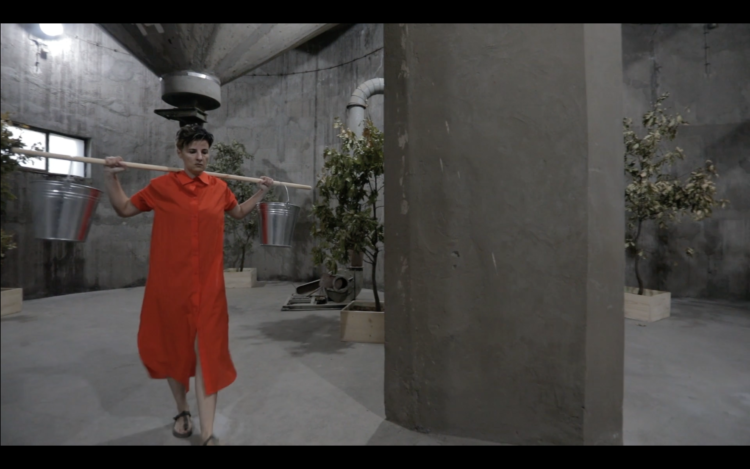
Sanja Latinović, ON TIME, 2021, live performance broadcast at VIDEO+RADIO+LIVE 2021, courtesy of Galeriei Catinca Tabacaru
The artist carries on her shoulders a yoke with two buckets of water, which she uses to water some dry suffering trees that are in a state of falling apart. She chooses water as her primary element, with its characteristic properties in the metabolic processes of trees, thereby intensifying the transfer of consecrated features of the exhibition space, which remains rigid and inflexible, through which the difficulty of achieving plant germination and growth in artificial, electrically lit, neutral spaces is brought into discussion. I remember an essay by researcher Audronė Žukauskaitė in which she speaks about the perceived need of creating a distinction between human and non-human by specifically isolating nature in botanical gardens, zoos, safaris, greenhouses, and museums, where I can observe the difference between myself and the Other, while at the same time being able to comfortably reinvent and assert my own humanity through the freedom I possess, that of choosing whether to act (or not), whether to repair (or not).
Trees are forced into contact with human environments that are, generally, unwelcoming for them, because of the imposed artificial conditions, which normalizes the fundamental virtue of temporarily using and objectifying nature in order to understand how, when, and in what conditions we are able to help. By investing in a series of tardy human actions, the artist seems to emphasize a brutal statement where we are confronted with our actions, with the stakes of the artistic act we have taken part in and which intervenes as a delayed reaction, a deferred answer.
And at this point I write down: Why dying trees? Where from? How? If the goal of the performance was becoming aware of our current crises – of an ecological nature as well as others – by depriving trees of their natural conditions, especially those in a state of decay, is Latinović not contradicting her own statement? Or is this an acknowledged self-critique? Is the lesser evil towards the greater good? I read the text written by Jelena Veljković Wilson in the exhibition catalogue and I stop at the following sentence: “Her works aim to trigger ruminations on concepts such as duty, need, and neglect.”
I realize that right now I could easily feel
duty,
need,
neglect.
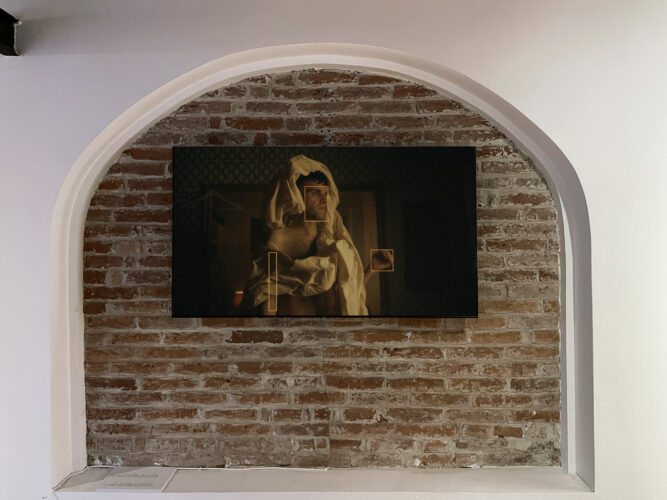
Madalina Zaharia and Ryan Ormonde, Public Figure, 2021, video performance at VIDEO+RADIO+LIVE 2021, courtesy of Ivan Gallery
I move on and arrive at the screen I had noticed, which emanates orange light and shows Madalina Zaharia and poet Ryan Ormonde’s work Public Figure. Four poems, associated with domestic images, invaded by a garish orange, by oranges, familiar objects, but also by a corporeal language engaged in fixed, scripted positions, intervene in the space through sound and sight. The staging of a text-body and a reflection-movement directs one towards understanding fluidity, of form in motion, of corporeal slowing-down. Ryan Ormonde’s movements are directed towards a means of knowing the character, both in an anticipated and programmed form that you can get used to quickly, in which getting close to them resembles a given of the constitutive formal elements (close-ups of the performer’s eye, vibrating music, soothing voice, rectangular framings of elements constituting the body and things around), as well as in a form where the attention is directed towards a new sensoriality, that of the incongruence between voice and body, between language and movement, to the detriment of versification as the emphasis of each sequence. I feel the need to associate the voice with a body, but I cannot fully do it. I recognize my experience with Public Figure as primarily auditory, acoustic, cognitive, as throughout the video I try not to miss anything from the content of the recited poems. I quickly write down:
The making of him.
The shape of an orange.
To anticipate what I’ve learned already.
Given that the video is not articulated narratively, in terms of editing, on the poet’s / performer’s, optical subjectivity, as the camera remains mostly distant, discreet, respectful, empathetically voyeuristic, I came to feel it was up to me to put together the discourse and the visuals. The voice-over, complemented by the non-diegetic music, by the texts that seem to become autonomous, to stretch over the images, to slide beyond the cognitive and hide behind the real images, behind the mundane clarity, gives me the feeling of a film that does not in fact need my help, that watches itself, understands itself, approves itself, and gives itself its own reactions and means of existence. I feel alone and move on.
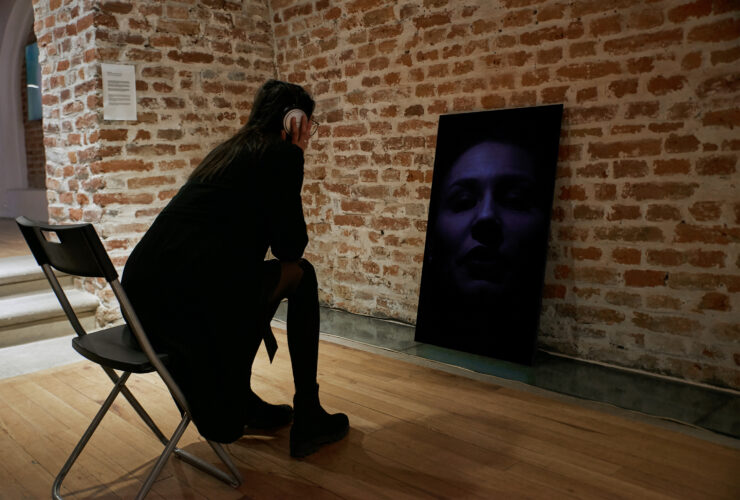
Silvia Amancei and Bogdan Armanu,GAME OVER, 2021, installation view at VIDEO+RADIO+LIVE 2021, courtesy of Ivan Gallery
The next two works, made by artist duo SABA (Silvia Amancei and Bogdan Armanu) but also by artist collective Apparatus 22 (Dragoș Olea, Erika Olea, and Maria Farcaș), are displayed on the same wall, modifying the tone and goals into an institutional critique that brings together, one by one, but each in its own logic, the impossibility of artistic concentration without a congruence within the Great Contemporary Art Discourses. I begin with SABA’s video work Game Over. The video shows the two artists’ faces, one by one, in a blue light pendulating with abrupt and reactive sentences.
Pathetism, and a strong belief in your own art, even if it’s shit, even if no-one asks, even if the world is burning. Bauhaus, must love it, must share it. Dating, anybody with a gallery, even curators will work, definitely somebody with a larger network than yours. Humour, jolly but don’t insult anyone, except the black listed
The first impression I get is that of a legitimate, well-articulated position that protests and confronts.
At the same time I think about the disposition of contemporary critiques and how they function. The dynamic proposed by SABA, one of accumulative critiques ordered in a convincing fashion, allocated to a familiar ironic space, is the definition of contemporary criticism, which passes axiological judgments, tells us what is right and what is wrong in what we do, and makes us realize that this cannot go on like this, that we have been caught or that we find ourselves within the created frames. This proposal can work, can be productive, with necessary results, while at the same time in danger of stumbling within its own principles. The abuse of criticism, verticality, and correctness do not cancel its vulnerabilities, and in this critical display, which is completely true and real, I still feel that something is missing.
Rich kid, don’t show off and the sky is the limit. Poor kids… game over.
At the same time, I am aware of the existence of other means of critically positioning yourself in a way that goes beyond the process of localizing, identifying, and blaming, though it still uses the apparatus and potentiality imposed by them; it does however leave space for a new cultural context in the shape of a subjectivity that sees beyond, that contaminates by offering chances, hope, and some kind of understanding. This is a method that is not harmful in itself; perhaps it is not yet game over, but game over and over, until we are able to potentialize this small cluster of possible and soothing ideas, actions, and speculations in a field where we can finally start (re)building.
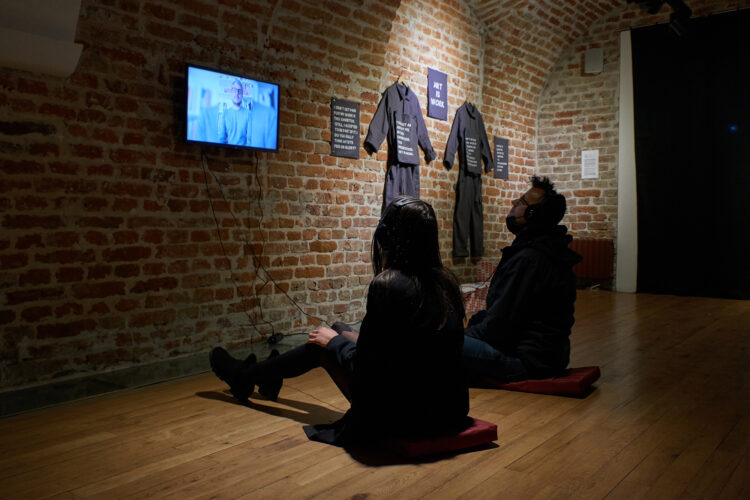
Apparatus 22, Art Is Work, 2011 – ongoing, installation at VIDEO+RADIO+LIVE 2021, image courtesy of Suprainfinit
I turn my attention to the installation ART IS WORK – Voices of a Community, made by Apparatus 22 as a call to solidarity with artists and curators, made up of two uniforms[1] with two complementary texts (an artist version and a curator version), a series of instructions on how to potentially win one in a raffle, but also a video of 7 curators/artists answering a series of questions: Why do you think that art/curating is work? Why is contemporary art vital to society? Do you have any dreams about new support structures for art (beyond money)?
Apparatus 22 proposes a trade: if you are one of those selected to receive a uniform, you will have to record yourself answering one or more of their questions, and the exhibited video represents some of the archived answers given by some artists/curators. I learn from Dragoș that at the end of this pilot project, the work will comprise around 200 such recordings. Furthermore, Apparatus have held an ongoing performance. I understood their wish to create a space for discussion, a space of openness towards the public, having a heightened awareness towards it, as the collective was almost constantly present in the space.
In the works of Apparatus 22 I have noticed a leaning towards captivating, safe aesthetic techniques that aim to make the viewer responsible through a series of elements related rather to attractive and already validated methods. One could easily reproach them for this, but I now come to realize that this precaution is not coincidental and supports its objectives. A kind of critical engagement displayed in a soft but self-aware aesthetics and structure whose purpose is to infiltrate, infect, and create spaces for discussion about real problems which are hard to answer confidently if you do not see them clad in something familiar, recognizable, part tough, part enjoyable.
Finally, I put on the headphones.
because it gives problems, no immediate solutions
I have a lot of daydreams about art
the Creation it’s like a gift
art market
While the first two questions generated answers still marked by a pressing frustration (an understandable one given the current situation of contemporary art), the answers to the question Do you have any dreams about new support structures for art? resonated with me the most. By proposing an imaginative exercise in the form of a dream, a wish connected to the field of art, a potentializing dimension of answers was opened, answers that could, in themselves, function as an artwork, distancing themselves from current discontent and driving forth a possible, hopeful vision for the future, like a boost of optimism and a small step towards something.
One answer stays with me, and I write it down almost ritualistically.
A day when everyone will choose to care and to be paid (for that) by the government. (Matylda Krzykowski – curator)
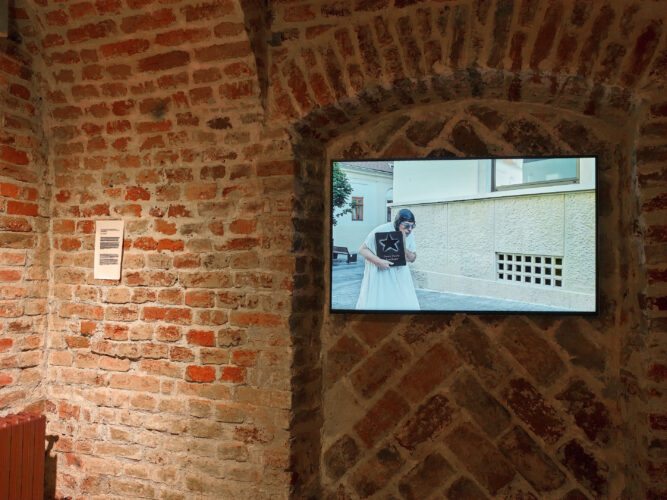
Alexandru Antik, Memories implanted in the landscape of everyday life, 2021, installation at VIDEO+RADIO+LIVE 2021, courtesy of Sector1 Gallery
As I remove my headphones I recognize David Bowie’s song Lazarus, and I turn around towards the last screen, finding the source of the sound to be artist Alexandru Antik’s video work Memories implanted in the landscape of everyday life. I feel that Antik’s work is not very clear to me. I don’t feel I can convey it in writing too faithfully. I understand that Alexandru Antik starts from his artistic manifestations in real spaces, which take the form of ritualistic actions, praying or crawling, in a filmic frame, in an extended form of interaction with a series of black-and-white photographs, reiterating, in as simple terms as possible, the past. This confluence between past and present, between the integrity of an action and the residues in its memory, seems to be the aim of Antik’s work.
“I asked myself what it would be like to invoke some of the memories of my actions, how I could implant them in the landscape of my current daily life. These actions – whose real or imaginary spaces had been chosen in connection to my symbolic message – have now lost their performative character or their characteristics as happenings. They are, rather, metaphorical promenades in search of memory, with the purpose of resurrecting our increasingly faded memories.” (Alexandru Antik)
After a long time spent in the first space, I head for the second one, passing through the inner courtyard, where, as in an initiation journey, I stop to see artist Catinca Mălaimare’s performance piece. Medium Bastard Amber is conceived as three iterations of the performance, 60 minutes each, for three consecutive days, at Casa Artelor. I couldn’t help notice the space created especially for this performance, which still shows the reality of the current dispersion of art in space in the (post-)pandemic period, through the presence of this cube stage with all kinds of props, with a screen showing the artist interacting with an LED-lamp-spider-object, but also with neon lights, chains, and magnets, which are positioned in this space that only the artist has access to, as the viewers are invited to watch from a certain distance.
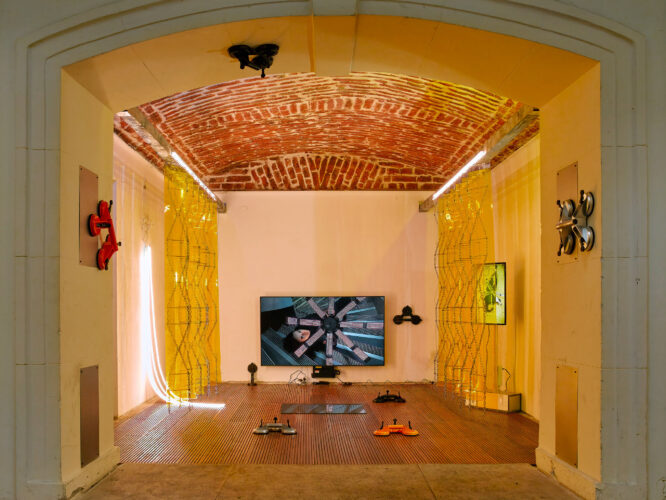
Catinca Malaimare, Medium Bastard Amber, 2021, live performance at Video+Radio+Live 2021, courtesy of Galeria Catinca Tabacaru
I write down:
What is Catinca looking at?
I notice the artist’s movements – rigid, complementing the objects she touches, imitative, not at all disruptive or invested. I try to pay attention to all the interacting sensorialities that meet in this transformative project of interacting with objects. The haptic level is reconsidered, and I see the objects not as mere props, but as unique dispositions of motion, affect, and sense, but also as registers in which the participatory dimension becomes an unproductive praxis within the unitary meaning of the scenes in relation to the viewers. I learn from the artist that her corporeal practice doesn’t aim to recreate the object, but to imitate it, and in this same register of sterility and sanctity of movement I feel a paradoxical combination of moods, something between impulsivity and detachment from the unitary meaning of the work. Catinca Mălaimare uses technology and the anthropomorphized climate to mediate a possible communication between human and object, a closeness, an intersection meant to generate something, using interaction and embodiment with a fully assumed premise, somehow trying to control her sensations, to experiment, to attempt, to learn how to do it. At the end of the performance, I feel the lack of finalization of this practice, of a certain fragility, of an improvised direction, of a space in which work is still being done.
After Catinca Mălaimare’s performance, I make my way into the second space. The atmosphere is different here, the room is dark, more spacious, with only two video works, facing each other.
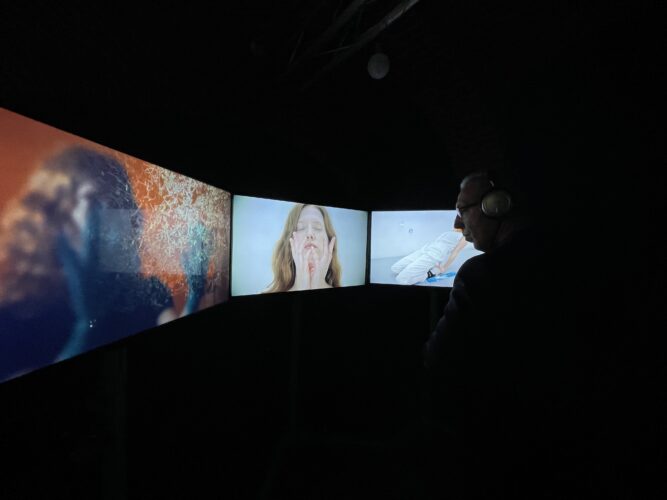
Rachel Monosov, LIMINAL, 2020, installation view at VIDEO+RADIO+LIVE 2021, courtesy of Galeria Catinca Tabacaru
The first video work, artist Rachel Monosov’s Liminal, displayed on three channels, refers to the liminal space as a space of healing through movement, a place where one’s own body rebels against what it no longer wants or is able to feel in the context of isolation and distancing from other bodies.
I begin to take notes: trances, meditation, poetic, heavy, blue, fall.
Rachel Monosov and Stephanie Amurao move in a trance, move in meditation, move poetically, move heavily, move in blue, and move in falling.
The profound questioning that I feel when it comes to presenting a world from a slightly different perspective, in which movement appears as a way of producing testimonies of lived experiences or repressed, unaccessed practices, seems to be interrupted by props or special effects. One of the images that stayed with me is that of the squares in the white floor of the space, in a supposed white cube, through which we could glimpse the sea and the waves, footholds for the performers in a perfectly balanced pose above them. Whether it’s a meditation in front of multicolored plants, attention directed towards the waves that move across the walls, or a kind of tense closeness between the performers, like a distant hug reminiscent of our current context, the effect is a series of corporeal frames and tensions that draw your attention and pique your curiosity.
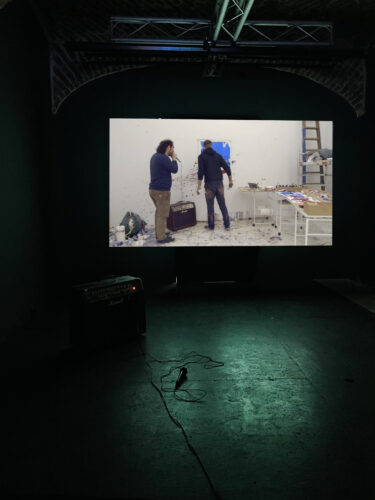
Navid Nuur and Adrian Ghenie, The Possibility of Purple, 2013, installation view at VIDEO+RADIO+LIVE 2021, courtesy Plan B gallery
In front of it is The Possibility of Purple, by artists Navid Nuur and Adrian Ghenie, perhaps the work I knew the most about before seeing it, given that it travelled quite a lot after first being exhibited at the first edition of Art Basel Hong Kong in 2013, where it was awarded the Discoveries Prize. The work shows Navid Nuur holding a microphone connected to a Marshall amplifier, through which he translates, as onomatopoeic, distorted sounds with no real referent, Adrian Ghenie’s movements as he paints. The end goal of the two artists’ effort is to problematize medial exchange, meant to bring to the forefront a new system of communication to allow for an exchange of abstract information in real time. Through this tense chain of sonic forces, a different kind of attention is created, one belonging to the viewer and able to offer narrative comprehension in the context of the given acoustic. I no longer think about what I see, but of what I hear. It sounds like something I have heard before, and I think of this translation as a speculative way of being and hearing from over there, from inside, a language of colors, forms, and the tensions between them on the canvas.
I write down as if for myself: art sounds, inside, like a burning field?
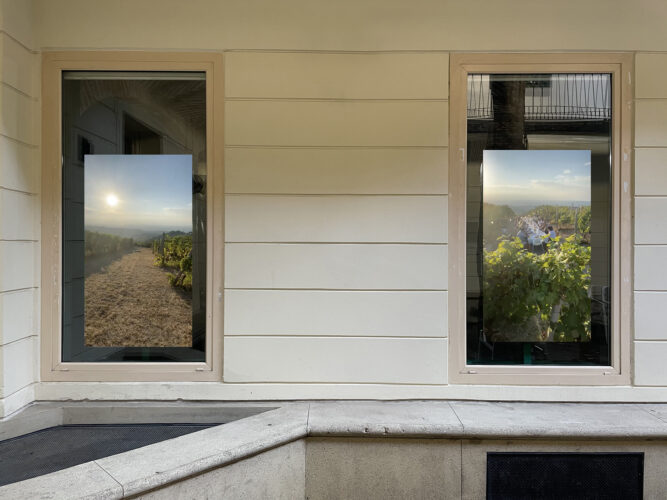
Daniela Palimariu, Vineyard Slips, 2021, installation view at VIDEO+REDIO+LIVE 2021, courtesy of Sandwich gallery
Finally, I return to the courtyard, where evening has already fallen, and I sit down at one of the long, white, comfortable tables. In front of me I see two screens, behind me two more. I realize that I have missed Daniela Pălimariu’s four-channel video work Vineyard Slips, which I searched for all night, but it was only visible from the courtyard. A video work showing people dining parallel to the tables in the courtyard. I like to think that this was not a coincidence, that it was conceived like this, like an installation, an overlap, a mise-en-abyme.
I go to each screen one by one. I am soothed by what I see. A group of people having dinner in an idyllic space, a scene of leisure, good spirits, animated discussions, familiarity, joy, friends, family, children. First, the alternation between general shots and unstable close-ups creates a different kind of attention, one which transcends linearity and clarity, leading to an understanding of a new way of observing, where even though the events and conversations are happening apparently naturally, freely, additional concentration is necessary. I feel the dialogues created and staged by Daniela Pălimariu as a sort of counterpoint to the landscape. I notice a formal succession of activations and deactivations of premises for a dialogued plot, with small games of allusions, intentional orders, all in a quiet, undisturbed setting.
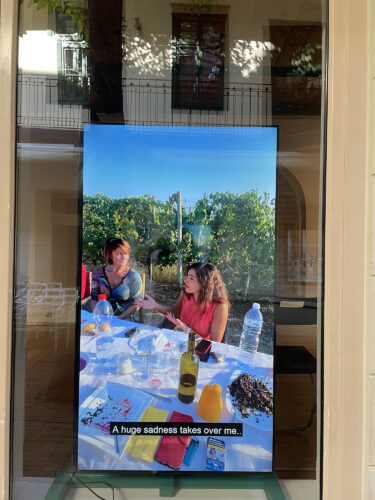
Daniela Palimariu, Vineyard Slips, 2021, installation view at VIDEO+REDIO+LIVE 2021, courtesy of Sandwich gallery
I turn from one screen to another. I watch two frames at the same time, and I try to pay attention to what I hear, in a way that makes me compare my experience to that of the dinner itself. The choice of scenes seems loaded with a reactive, well-thought-out message, given the use of clear, warm, soothing images, in the middle of nature, which the viewer consumes, but in a period charged with tension and angst, which transpires from the fragile conversations between the characters. The consumption of such images becomes a necessity, and the revitalization of relations, simple activities in nature, reclaims the importance of closeness and coexistence as a way of understanding the collective, unitary life of people as a way of being, of forwarding each other’s interests and needs.
I mechanically write down and circle: A work as a revolt, as a refusal with a twist.
The exhibition VIDEO+RADIO+LIVE can be visited until 31 October at Casa Artelor, Timișoara.
[1] The uniforms were inspired by the Tuta, a piece of clothing conceived a century ago by Italian designer and artist Thayaht, recognized for his involvement in the Italian Futurist movement.
Translated by Rareș Grozea
POSTED BY
Daniela Custrin
Daniela Custrin (b.1997) graduated from the master’s program at the Center of Excellence in Image Studies with a thesis titled "Fluturele vitruvian" [The Vitruvian Butterfly] which followed the dece...


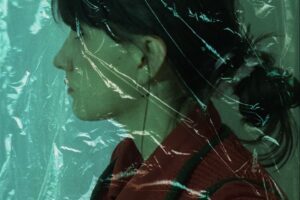
Comments are closed here.